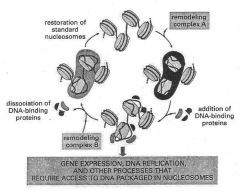![]()
![]()
![]()
Use LEFT and RIGHT arrow keys to navigate between flashcards;
Use UP and DOWN arrow keys to flip the card;
H to show hint;
A reads text to speech;
28 Cards in this Set
- Front
- Back
|
What percentage of the 3 billion BP long genome is coding DNA?
|
4-5%
|
|
|
The evolution of DNA packaging into chromosomes allowed _____ _______ to evolve.
|
large genomes
|
|
|
What is a karyotype?
|
The number and visual appearance of the chromosomes in the cell nuclei of an organism or species
i.e. the human karyotype consists of 44 autosomes and two sex chromosomes (male = 46 XY, female = 46 XX) |
|
|
What is an autosome?
|
Any chromosome that is not a sex chromosome
|
|
|
When chromosomes are in the nucleus, what are they referred to as?
|
Chromatin
|
|
|
What is a DNA strand wrapped around a histone protein called? How many base pairs wrap around it?
|
A nucleosome. 175
|
|
|
What are nucleosomes coiled into?
|
Chromatin fibres.
The string of beads is wrapped to another histone protein to the spacer between the nucleosomes. |
|
|
The loops of chromatin fibre are attached to...
|
...a central scaffold
|
|
|
What are the three elements of chromosomes?
|
Telomere, replication origin, centromere
|
|
|
What is a centromere?
|
A DNA element responsible for segregation of chromosomes at mitosis and meiosis (where spindles attach)
|
|
|
What is a telomere?
|
A specialised structure that comprise DNA and protein - involved in sealing the ends of the chromosome and confer chromosome stability.
They are protective 'caps' on chromosomes consisting of 5-8bp repeated. They prevent chromosomes from fusing and causing karyotypic rearrangements |
|
|
What is the replication origin?
|
A part required to initiate DNA replication and maintain chromosomal copy number
|
|
|
What enzyme is required to maintain telomere length in germline (cells that give rise to the gametes) cells?
|
Telomerase
|
|
|
Most differentiated somatic cells have decreased levels of telomerase and therefore their chromosomes shorten with each cell division.
|
.
|
|
|
Females have two X chromosomes, but only one is required for normal, balanced gene expression - one is RANDOMLY inactivated - inactivation occurs during development at the blastocyst stage.
|
Different clones may have different X chromosomes activated.
|
|
|
What are the five functions of mammalian chromosomes?
|
Dense packaging of DNA
Allow and coordinate DNA replication Allow correct division of copies during mitosis Allow recombination correct independent assortment during meiosis Allow coordinated gene expression |
|
|
What is the shape of the mitochondrial genome? How many genes does it have?
|
Circular, 37 genes
|
|
|
What is an 'alu sequence'?
|
A repeated sequence of about 300 bp that often contains a cleavage site for the restriction enzyme AluI near the centre; about 1 million copies in the human genome.
Fund adjacent to or within genes in introns or nontranslated regions |
|
|
What is satellite DNA? Where is it usually found?
|
Highly repeated, low complexity sequences. Usually located in centromeres and telomeres
|
|
|
What is a cistron?
|
A section of a DNA or RNA molecule that codes for a specific polypeptide in protein synthesis
|
|
|
What is the current accepted definition of a gene?
|
That which consists of all the DNA sequences necessary to produce a single polypeptide or RNA product.
|
|
|
Do prokaryotic cells have introns?
|
Nein!
2248181010 |
|

|
.
|
|
|
In the chromatin state, DNA is too tightly wrapped around histones - it needs to be spaced out for DNA binding proteins to act. What is the name that spaces out, and what is the name that tightens up to nucleosomes?
|
Remodelling complex A unpacks
Remodelling complex B tightens |
|
|
What is linker DNA?
|
DNA that lies between nucleosomes
|
|
|
What is a 5' cap?
|
A specially altered nucleotide vital to creating mature messenger RNA, which is then able to undergo translation. Capping ensures the messenger RNA's stability while it undergoes translation in the process of protein synthesis
|
|
|
Which end is the 5' end?
|
The phosphate end
|
|
|
What is a poly(A) tail, and what is it for?
|
A stretch of RNA which only has Adenine bases, helpful for the nuclear export, translation and stability of mRNA
|

